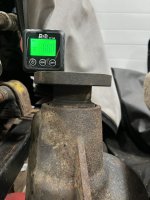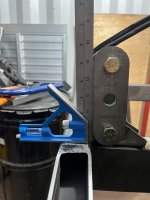[memphis]
Web wheeler
- Joined
- Jun 6, 2020
- Member Number
- 1867
- Messages
- 707
I understand Caster from a basic sense. I know the interwebs says it needs to be around 4-8 degrees to help with wander on the road.
Does wheel base length have any factor in setting caster? I will be running 86” wheel base and running leaf springs under the axle.
I am building a low slung willys like Rango running 2.5” YJ springs all four corners
The front axle is a passenger drop HP44 so I have a pretty blank slate. Essentially I am doing a basic cut and turn. I’m past the cut part and need to complete the turn.
I was thinking about setting the pinion at 90 degrees (referencing the machined flats on the housing) and Setting caster at like 10 to slightly compensate for rolling the pinion up if required?
I measured a JK Rubi axle (2 door if that matters) sitting in my buddies garage prepping for a swap and with the pinion at 90 degrees the caster is about 4.2 degrees. Doing a little googling that appears to be the factory spec?
I know there are a bunch of other factors… driveshaft type will affect pinion angle, vehicle weight, but I’m stuck in a bit of a project paralysis at the moment…
I have lock outs so I don’t think pinion angle is going to be super critical especially since I am not going to be sitting sky high… 10 might be a bit much, do I shoot for 7-8 and worst case it needs to go positive 2-3 degrees?
Does wheel base length have any factor in setting caster? I will be running 86” wheel base and running leaf springs under the axle.
I am building a low slung willys like Rango running 2.5” YJ springs all four corners
The front axle is a passenger drop HP44 so I have a pretty blank slate. Essentially I am doing a basic cut and turn. I’m past the cut part and need to complete the turn.
I was thinking about setting the pinion at 90 degrees (referencing the machined flats on the housing) and Setting caster at like 10 to slightly compensate for rolling the pinion up if required?
I measured a JK Rubi axle (2 door if that matters) sitting in my buddies garage prepping for a swap and with the pinion at 90 degrees the caster is about 4.2 degrees. Doing a little googling that appears to be the factory spec?
I know there are a bunch of other factors… driveshaft type will affect pinion angle, vehicle weight, but I’m stuck in a bit of a project paralysis at the moment…
I have lock outs so I don’t think pinion angle is going to be super critical especially since I am not going to be sitting sky high… 10 might be a bit much, do I shoot for 7-8 and worst case it needs to go positive 2-3 degrees?


 Is it possible to set the housing under the vehicle on jack stands, and then just kind of eyeball where you think the pinion angle should be? Thats basically all we did when we built my front D60.
Is it possible to set the housing under the vehicle on jack stands, and then just kind of eyeball where you think the pinion angle should be? Thats basically all we did when we built my front D60.

